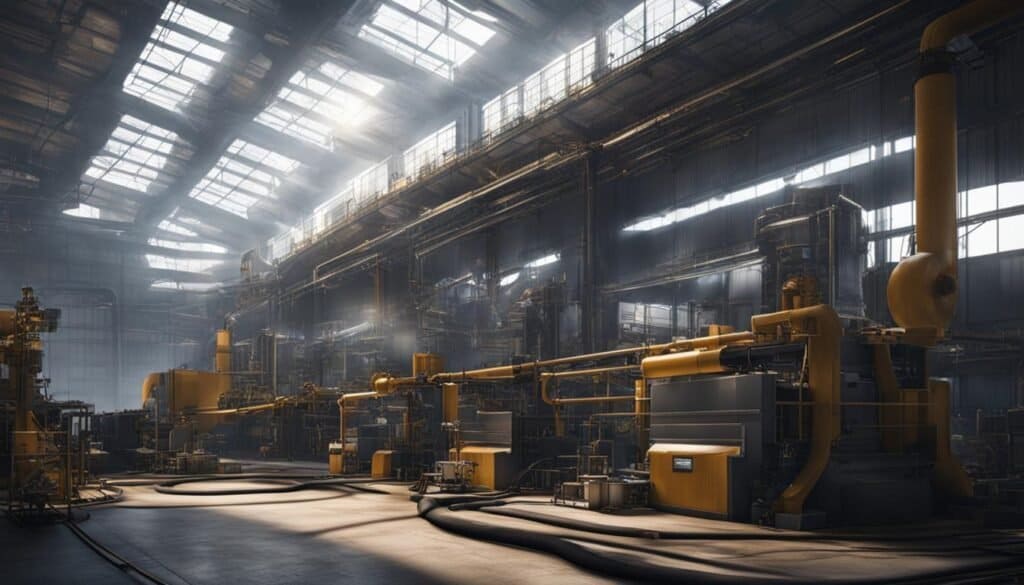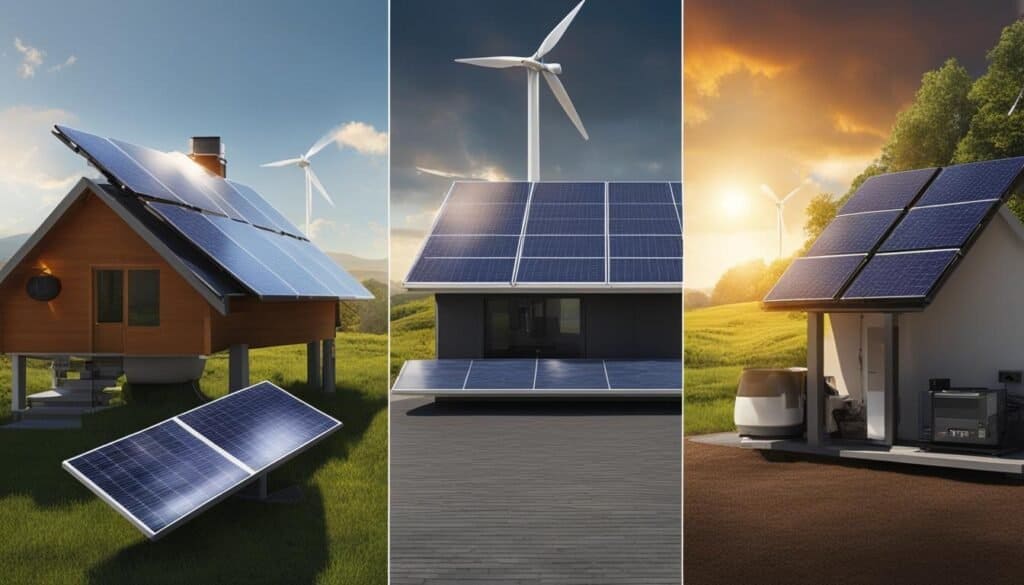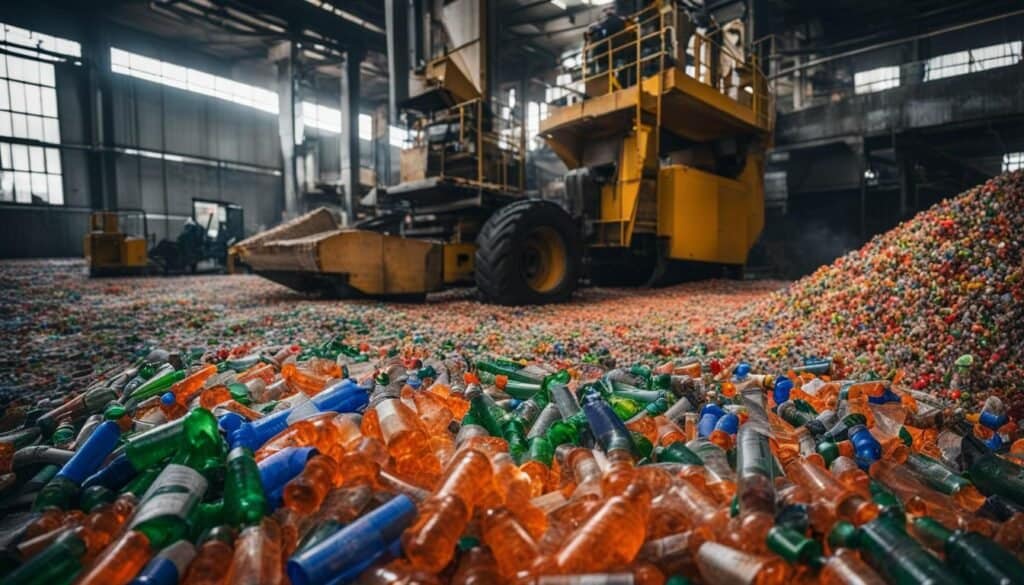As concerns about environmental sustainability and renewable energy continue to rise, the manufacturing sector faces mounting pressure to adopt eco-friendly and energy-efficient green manufacturing processes. Companies around the world are increasingly recognizing the benefits of sustainable manufacturing practices, which not only help in emission reduction and energy conservation but also pave the way for cost savings and brand reputation enhancement.
In this guide, I will discuss the various green technologies and innovative strategies available to businesses striving to revolutionize their operations and develop truly sustainable products.
Key Takeaways:
- Green manufacturing processes contribute to emission reduction and energy conservation in the manufacturing sector.
- Adopting sustainable manufacturing practices can lead to cost savings and improved brand reputation.
- Renewable energy sources, such as solar, wind, and hydropower, play a significant role in eco-friendly manufacturing.
- Resource management and innovative production methods are crucial to achieving sustainability in manufacturing.
- Lean manufacturing and just-in-time production methods complement sustainable practices by optimizing resources and processes.
Understanding the Significance of Sustainable Manufacturing
Sustainable manufacturing is a modern approach to producing goods with minimal human and environmental impacts. It focuses on resource conservation, safety, and the implementation of eco-conscious methods across the entire manufacturing process. This ideology is built upon the foundation of the triple bottom line, which emphasizes a balanced focus on three interconnected aspects: the economy, environment, and society, commonly referred to as people, planet, and profit.
“Sustainable manufacturing aims to achieve profitable growth while preserving natural resources, promoting environmental stewardship, and enhancing the well-being of employees and communities.”
- Economy: Encouraging profitable growth and cost-effective quality improvement measures.
- Environment: Considering the ecological impact of manufacturing stages, including raw material extraction, energy consumption, and emissions.
- Society: Improving the conditions for employees and local communities by promoting well-being, community enhancement, and product safety.
By prioritizing these three pillars throughout the manufacturing process, sustainable manufacturing delivers a plethora of benefits, which include:
- Reduced resource and energy consumption
- Increased utilization of renewable resources
- Minimized waste generation
- Enhanced operational safety
- Cost-effective quality improvements
| Pillar | Focus | Examples |
|---|---|---|
| Economy | Profitable growth | Efficient resource management, waste minimization, cost reductions |
| Environment | Ecological impact | Reduced emissions, renewable energy use, sustainable materials |
| Society | Well-being and safety | Employee satisfaction, community engagement, product safety |
Ultimately, sustainable manufacturing supports companies in meeting the evolving demands of both customers and regulatory authorities by producing goods that have a minimal environmental footprint, adhere to product safety requirements, and enhance the well-being of employees and surrounding communities.
The Growing Emphasis on Renewable Energy in Manufacturing
As the global need for sustainable solutions rises, manufacturers are increasingly focusing on renewable energy sources to minimize carbon emissions and go green. By integrating solar power, wind power, hydropower, biomass power, and geothermal power into their operations, companies can significantly reduce their environmental impact, contribute to the energy transition, and benefit from cost savings.
Integrating Solar, Wind, and Hydropower Sources
Solar, wind, and hydropower are among the most prevalent renewable energy sources for sustainable manufacturing. By harnessing the power of these natural resources, companies can conserve energy while reducing their carbon footprint. Furthermore, implementing renewable energy systems like solar panels on manufacturing facilities can lead to long-term financial benefits due to lower energy costs and potential incentives provided by governments and utility companies.
Utilizing Biomass and Geothermal Energy in Production
Biomass power and geothermal energy offer promising alternatives to traditional energy sources in the manufacturing sector. By embracing these environmentally friendly methods, companies can support the shift towards energy-efficient manufacturing processes and contribute significantly to emission reduction. Additionally, tapping into these sustainable energy sources can help businesses solidify their reputation as green manufacturers and attract customers who prioritize sustainability.
Investing in Renewable Energy Credits and Carbon Offsets
Manufacturers can further demonstrate their commitment to sustainability by investing in renewable energy credits and carbon offsets. These instruments allow companies to mitigate their environmental impact by supporting projects that focus on renewable power generation, energy-efficient technologies, or other emission reduction initiatives. By incorporating sustainable business practices and actively participating in efforts to promote sustainable energy sources, manufacturing companies can help drive the transition towards a greener future.
“Investing in renewable energy credits and carbon offsets allows manufacturers to show their dedication to sustainable practices and create a positive impact on the environment.”
Through ongoing efforts to adapt and implement renewable energy sources, manufacturers are not only contributing to a cleaner environment but also reaping financial benefits from more energy-efficient processes. As the demand for sustainable manufacturing continues to grow, adopting these renewable energy solutions will become increasingly vital for business success.
Energy Conservation Strategies for Greener Production

Energy conservation is a crucial aspect in sustainable manufacturing, helping businesses achieve greener production while saving costs. Implementing state-of-the-art strategies ensures that manufacturers use less energy, reduce waste, and promote energy efficiency. In this section, we’ll discuss various energy conservation strategies, such as cogeneration, waste heat recovery, and the adoption of energy-efficient systems and controls.
Optimize Energy Usage Patterns and Use Lighting Controls: As per Border States, adjusting and automating energy usage patterns, especially in lighting, can result in significant energy savings in manufacturing plants.
Cogeneration, also known as combined heat and power (CHP), is a highly efficient energy-saving strategy that generates electricity and useful heat simultaneously. By using the waste heat produced during the electricity generation process, cogeneration systems can achieve energy savings of up to 30%, contributing to both energy efficiency and significant cost reduction.
- Waste Heat Recovery (WHR) is another effective method for energy conservation. Manufacturers can reclaim heat from various industrial processes and use it for heating or electricity generation, substantially reducing energy waste and consumption. Waste heat recovery systems provide dual benefits – they lower overall energy usage and cut costs by reusing energy that would otherwise be lost.
- Energy Management Systems (EMS) are crucial for optimizing energy usage in manufacturing facilities. These advanced systems monitor, control, and optimize energy consumption, allowing manufacturers to identify areas for improvement and implement energy-saving measures. An effective EMS promotes energy efficiency while offering valuable insights for continuous improvement.
- Variable Speed Drives (VSDs) are an essential component in energy conservation. VSDs adjust motor speed based on the workload, leading to energy savings as the motor consumes only the necessary energy to perform its function. Variable Speed Drives can significantly reduce energy consumption, lowering operating costs and contributing to a greener production process.
“Energy conservation is not only a responsible and environmentally friendly approach, but it also contributes to the financial health of a manufacturing business by reducing operating costs.”
Alongside these primary strategies, manufacturers can also adopt other methods to optimize energy usage, such as:
- Installing lighting controls to reduce the use of artificial lighting and cut energy waste
- Implementing demand response programs that adjust energy consumption based on real-time energy supply and demand
- Using energy-efficient lighting options like LEDs to reduce energy consumption
By incorporating energy conservation strategies, manufacturers can significantly enhance production efficiency, waste less energy, and reduce related costs. These approaches aren’t just eco-friendly; they also make good business sense, laying the foundation for sustainable, profitable growth within the manufacturing industry.
Strategies to Maximize Resource Efficiency

Energy efficiency plays a crucial role in sustainable manufacturing, wherein maximizing resources, reducing waste, and cutting costs are prioritized. In this section, we will discuss two essential approaches to boost resource efficiency in manufacturing through implementing waste heat recovery systems and advancing the adoption of smart grids and microgrids.
Implementing Waste Heat Recovery Systems
Waste heat recovery systems facilitate energy savings and enhance efficiency by capturing and reusing heat emitted during the manufacturing process. This approach not only conserves energy but also contributes to reducing the overall energy consumption of the facility.
Waste heat recovery systems capture heat generated in manufacturing processes and reuse it, improving resource efficiency and significantly reducing energy consumption.
Industries such as cement production, glass manufacturing, and metal processing, generate vast amounts of waste heat. By investing in efficient waste heat recovery systems, these industries can capitalize on enormous energy savings.
Advancing the Adoption of Smart Grids and Microgrids
Smart grids and microgrids are advanced energy management systems that optimize energy use and storage while intelligently managing energy demands. These forward-looking technologies offer an array of sustainable energy solutions, including demand response, energy use optimization, and efficient integration of renewable energy sources.
- Smart grids enable real-time monitoring of energy production, consumption, and distribution, providing valuable insights for efficient energy management.
- Microgrids are localized energy distribution systems that can operate independently from the main grid, offering more control over energy usage and enhancing resiliency in case of power outages.
Manufacturers can benefit from these advanced energy management systems by integrating renewable energy sources, optimizing energy distribution, and reducing carbon emissions.
| Strategies | Benefits |
|---|---|
| Waste Heat Recovery Systems | Reduces overall energy consumption, conserves energy, enhances efficiency |
| Smart Grids and Microgrids | Optimizes energy use and storage, supports renewable energy integration, improves energy management |
Incorporating these strategies into the energy-efficient green manufacturing process leads to higher resource efficiency, sustainable practices, and reduced costs. By adopting waste heat recovery systems, smart grids, and microgrids, manufacturers can move towards more sustainable, smart manufacturing practices while ensuring substantial long-term benefits.
Reducing Carbon Footprint with Advanced Energy Management Systems
As industries worldwide strive to reduce their carbon footprint and contribute to a more sustainable future, the role of advanced energy management systems in achieving this goal is becoming increasingly significant. These systems are designed to help manufacturers optimize energy consumption, minimize environmental impacts, and promote energy-efficient manufacturing processes. In turn, adopting advanced energy management systems leads to not only environmental sustainability but also substantial financial savings.
Advanced energy management systems utilize cutting-edge software and hardware technologies to monitor and control energy usage in real-time. Some of the primary objectives of these systems include reducing energy waste, enhancing the efficiency of energy-intensive processes, and identifying opportunities to optimize energy use in every aspect of manufacturing operations.
- Monitoring and analytics: These systems collect, store, and analyze large volumes of data to provide a comprehensive view of energy usage patterns. This data-driven approach allows manufacturers to identify potential inefficiencies and fine-tune energy-consuming processes.
- Control and optimization: By automating key energy management functions, advanced systems enable manufacturers to reduce energy consumption during production. This includes optimizing equipment settings and even adjusting production schedules in response to fluctuations in energy demand or supply.
- Demand-side management: Manufacturers can leverage advanced energy management systems to actively participate in demand-side management initiatives. These initiatives promote energy conservation and financial savings by incentivizing users to reduce energy consumption during peak periods, such as utility demand-response programs.
With the increasing threat of climate change and escalating energy costs, the successful implementation of advanced energy management systems has become an essential factor in the transition to more sustainable production processes.
Embracing advanced energy management systems is a vital step toward green manufacturing methods and environmental sustainability, allowing manufacturers to play a proactive role in reducing their carbon footprint while enhancing efficiency and cutting down on energy costs.
Ultimately, the adoption of advanced energy management systems is an investment in the long-term viability of a company’s operations and its commitment to environmental stewardship. By opting for these systems, manufacturers can ensure a sustainable and energy-efficient production process, optimizing energy use and taking a step closer to a greener future.
Green Building Concepts in the Manufacturing Setting

As the focus on sustainable practices continues to grow, manufacturers are increasingly incorporating green building concepts in their facilities. These eco-friendly designs and methods help promote energy efficiency, reduce environmental impact, and support sustainable manufacturing operations.
Switch to Non-Fossil Fuel Energy Sources: TUVSUD advises that reducing carbon emissions can be achieved by switching from fossil fuels to cleaner energy sources like hydroelectric or nuclear power.
Incorporating Passive Solar Design and Natural Ventilation
Passive solar design and natural ventilation are key components of sustainable building that have been implemented in various manufacturing settings. These features maximize the efficient use of sunlight and natural airflow, reducing the need for artificial lighting and cooling systems. For instance, strategically placed windows and skylights can provide daylighting, while proper building orientation and insulation materials can enhance temperature regulation. These measures collectively contribute to a decrease in energy use and foster environmentally responsible facilities.
Exploring the Benefits of Green Roofs and Cool Roofs
Green roofs and cool roofs are two additional green building features that offer multiple benefits in manufacturing facilities. Green roofs, which involve planting vegetation on building rooftops, provide natural insulation, reduce heat absorption, and promote biodiversity. In contrast, cool roofs use reflective materials and coatings to minimize heat absorption, lowering the facility’s overall temperature and decreasing energy costs related to air conditioning.
Both green roofs and cool roofs:
- Improve insulation, reducing heating and cooling needs
- Decrease energy use, leading to cost savings
- Help mitigate the urban heat island effect
- Enhance the facility’s overall sustainability and environmental performance
By incorporating these green building concepts into their operations, manufacturers can actively work towards establishing energy-efficient, eco-friendly building materials and designs that support sustainable infrastructure and practices in the long term.
Water Conservation Tactics for Sustainable Manufacturing
Water conservation is integral to sustainable manufacturing practices. It not only ensures efficient use of precious natural resources but also aligns with the principles of environmental management. By adopting various water conservation tactics, manufacturers can significantly minimize their water consumption and contribute to a more eco-friendly manufacturing process. Some of these tactics include rainwater harvesting, greywater reuse, and the use of low flow fixtures.
Effective water management in manufacturing preserves natural resources and helps companies minimize waste and reduce environmental impacts.
- Rainwater Harvesting: Collecting and storing rainwater is an excellent way to conserve water in the manufacturing setting. Rainwater harvesting systems collect water from rooftops and other surfaces, which can then be utilized for cooling, cleaning, or even as process water. This practice not only reduces dependency on freshwater resources but also contributes to stormwater management and groundwater recharge.
- Greywater Reuse: Greywater is the gently used water from sources such as sinks, showers, and washing machines. By installing greywater reuse systems, manufacturers can redirect this water to non-potable applications in the manufacturing process, such as irrigation, cooling, and cleaning. This reduces the overall demand for fresh water, easing the strain on limited resources.
- Low Flow Fixtures: Low flow fixtures reduce water consumption without affecting the performance of the equipment. By replacing conventional fixtures with high-efficiency models, manufacturers can save water and reduce operating costs. Low flow fixtures are available for a variety of applications, including faucets, toilets, and showerheads, making them an easily implementable water-saving measure.
Besides these key strategies, manufacturers can also enhance their water conservation efforts by conducting regular water audits, monitoring water usage closely, and investing in water-efficient technologies. Commitment to water stewardship not only results in a more sustainable manufacturing process, but also showcases a company’s dedication to preserving the environment for future generations.
| Water Conservation Tactic | Benefits |
|---|---|
| Rainwater Harvesting | Reduces dependency on fresh water, contributes to stormwater management, and recharges groundwater reserves. |
| Greywater Reuse | Conserves fresh water, reduces strain on wastewater treatment facilities, and creates a closed-loop system within the manufacturing process. |
| Low Flow Fixtures | Saves water and cuts operating costs without sacrificing equipment performance. |
In conclusion, water conservation is a critical aspect of sustainable manufacturing for responsible companies. By adopting practices like rainwater harvesting, greywater reuse, and employing low flow fixtures, manufacturers can effectively manage their water consumption, enhance environmental management, and promote sustainable business practices.
Materials Management: Using Recycled and Biodegradable Options

In today’s eco-conscious world, materials management plays a crucial role in sustainable manufacturing. Companies are increasingly turning to recycled and biodegradable materials to reduce waste and create environmentally friendly products. By utilizing sustainable materials and adopting eco-friendly production processes, manufacturers can ensure alignment with environmentally friendly manufacturing and sustainable business practices.
Utilizing Certified Wood and Rapidly Renewable Materials
Choosing the right materials significantly impacts the eco-friendliness of a product’s design. By integrating certified wood and rapidly renewable materials, businesses can engage in sustainable sourcing and align with green procurement. These materials have a lower environmental impact, supporting the creation of eco-friendly products and contributing to a more sustainable product design. Examples of rapidly renewable materials include bamboo, cork, and straw, which are fast-growing and easily replenished resources.
“Sustainable sourcing of materials not only benefits the environment but also strengthens brand reputation and market appeal.”
Embracing Cradle-to-Cradle Design and Non-Toxic Materials
Incorporating cradle-to-cradle design principles and non-toxic materials into manufacturing workflows is another effective strategy. This approach encompasses designing products with their entire life cycle in mind, optimizing resource use and minimizing negative environmental impacts. By selecting environmentally friendly materials and engaging in life cycle assessments, businesses can create sustainable products while reducing their ecological footprint.
| Material | Environmental Benefits |
|---|---|
| Recycled aluminum | Reduces energy consumption and lowers greenhouse gas emissions |
| Recycled plastic | Conserves resources and prevents plastic waste from entering landfills and oceans |
| Recycled paper and cardboard | Decreases deforestation and saves water and energy compared to virgin paper production |
| Biodegradable packaging materials | Reduces waste by breaking down safely into natural components |
Adopting materials management strategies centered on recycled and biodegradable options enhances sustainability efforts within a manufacturing process. By investing in eco-friendly materials, companies can demonstrate their commitment to preserving the environment and make a positive impact on both society and the planet.
Driving Innovation with Biomimicry and Green Chemistry
In the quest for more sustainable manufacturing, biomimicry and green chemistry are playing increasingly vital roles. These innovative approaches inspire manufacturers to develop novel, environmentally responsible techniques that reduce pollution and enhance product safety, while also tapping into nature’s inherent efficiency and design prowess.
Biomimicry involves studying and imitating nature’s time-tested strategies to create new and sustainable methods for the production process. Examples of biomimicry in action include the development of highly efficient wind turbine blades inspired by the aerodynamic design of humpback whale flippers, and Velcro’s ingenious hook-and-loop mechanism, which mimics the way burrs cling to animal fur.
“By seeking nature’s solutions to human problems, we can create cutting-edge, sustainable technologies that benefit both industries and ecosystems alike.”
Green chemistry, on the other hand, promotes the use of environmentally friendly chemical processes that reduce or eliminate the generation of hazardous substances. These solutions prioritize safety, waste prevention, and energy efficiency. One example of green chemistry is the development of biodegradable plastics made from raw materials like corn starch, soybean oil, or cellulose, which replace traditional plastics derived from petroleum and natural gas.
Together, biomimicry and green chemistry drive sustainable innovation, pushing the boundaries of what is possible in manufacturing while reducing the industry’s environmental impact. The following table showcases noteworthy examples of biomimicry and green chemistry in action:
| Category | Example | Description |
|---|---|---|
| Biomimicry | Lotus Effect | Self-cleaning surfaces inspired by the water-repellent microscopic structure found on lotus leaves, leading to the creation of anti-fouling materials. |
| Biomimicry | Gecko Tape | A reusable, adhesive material inspired by the way geckos’ feet can cling to surfaces, which uses micro-scale hairs to generate effective, residue-free attachment. |
| Green Chemistry | Biobased Polymers | Environmentally friendly polymers derived from renewable biomass resources, which can replace traditional materials in various applications and reduce the industry’s reliance on petroleum-based materials. |
| Green Chemistry | Water-based Paints | Paint formulations that use water as their primary solvent, minimizing the release of harmful volatile organic compounds (VOCs) and improving indoor air quality. |
As the manufacturing sector continues to embrace sustainable methods, technologies inspired by biomimicry and founded upon the principles of green chemistry promise to deliver tangible environmental benefits. By championing these innovative approaches, manufacturers can ensure a greener, more sustainable future.
Adopting Lean Manufacturing and Just-in-Time Production for Sustainability
Both lean manufacturing and just-in-time production methodologies can play a significant role in promoting sustainable manufacturing practices. By streamlining production processes and efficiently managing resources, these approaches help to increase efficiency and productivity while all the while working to decrease waste, support zero waste initiatives, and prevent pollution. Additionally, they help businesses reduce costs and improve overall supply chain management.
Both lean manufacturing and just-in-time production emphasize a set of core principles and practices that work towards achieving sustainable manufacturing. Let’s take a closer look at these methods and their benefits:
- Elimination of waste: Lean manufacturing emphasizes reducing waste in production processes by refining the use of materials, energy, and labor. This leads to less landfill waste, pollution, and resource consumption, while also ensuring that processes are as efficient as possible.
- Continuous improvement: Organizations that adopt lean manufacturing strive to achieve continuous improvement in their production processes, identifying and addressing inefficiencies that lead to waste and environmental impact. This approach aligns with the principles of sustainable manufacturing by promoting more efficient use of resources, ultimately lessening the overall environmental footprint.
- Just-in-time production: Focusing on the timely delivery of materials and products, just-in-time production entails producing only what is needed when it’s needed. This helps to minimize overproduction, excess inventory, and waste, while also enabling organizations to respond more quickly to changes in customer demand.
- Optimized supply chain management: Both lean manufacturing and just-in-time production emphasize the importance of managing the entire supply chain effectively. By optimizing relationships with suppliers and customers, businesses can establish more resilient and responsive supply networks, driving sustainability initiatives throughout the entirety of the chain.
To illustrate how lean manufacturing and just-in-time production can contribute to your organization’s sustainability goals, the following table provides an overview of their benefits in comparison to traditional manufacturing practices:
| Aspect | Traditional Manufacturing | Lean & Just-in-Time Manufacturing |
|---|---|---|
| Waste | More waste, including materials, energy, and time | Significantly reduced waste |
| Efficiency | Lower operational efficiency | Higher operational efficiency |
| Productivity | Possible overproduction and excess inventory | Increased productivity and optimal inventory management |
| Pollution Prevention | Higher risk of pollution and environmental damage | Decreased pollution due to efficient resource utilization |
| Cost Reduction | Higher resource costs | Lower material, energy, and operating costs |
| Supply Chain Management | Less integrated and efficient supply network | Optimized, efficient, and flexible supply network |
By integrating lean manufacturing and just-in-time production methods into your organization’s operations, you can foster a culture of sustainable manufacturing that supports waste reduction, pollution prevention, and cost savings while simultaneously promoting efficiency and productivity throughout the entire supply chain.
Switch to Non-Fossil Fuel Energy Sources: Evocon advises that reducing carbon emissions can be achieved by switching from fossil fuels to cleaner energy sources like hydroelectric or nuclear power.
Conclusion on Green Manufacturing
Sustainable manufacturing plays a crucial role in future-proofing businesses by enhancing the brand reputation and attracting eco-conscious customers. By implementing energy-efficient and cost-saving strategies, businesses can thrive in a competitive market while reducing their impact on the environment. Green industrial practices not only promote sustainability but also drive continuous improvement and innovation in production.
Manufacturers who adopt sustainable practices not only contribute to a healthier planet, but also reap numerous benefits such as cost reduction, improved brand image, and increased loyalty from eco-conscious consumers. By forging clear goals and judicious resource management, adopting green materials, and innovating production processes, manufacturers can partake in crafting a more sustainable future.
As the world moves towards prioritizing sustainability, it has become increasingly important for businesses in the manufacturing sector to adapt and implement sustainable practices. Embracing sustainable manufacturing is not just a trend; it is a strategic decision that paves the way for a more responsible and economically viable business model. In summary, sustainable manufacturing positively impacts businesses, customers, and the environment, leaving behind a legacy of a cleaner, greener future for all.
FAQ on Energy-Efficient Green Manufacturing Process
Q: What is green manufacturing?
A: Green manufacturing refers to the production of goods using sustainable processes that minimize negative environmental impact, conserve energy, and reduce waste and pollution.
Q: Why is it important for manufacturing companies to go green?
A: Manufacturing companies need to go green to reduce their environmental footprint, save energy costs, meet regulatory requirements, and appeal to eco-conscious consumers.
Q: What are some examples of green technologies used in manufacturing?
A: Some examples of green technologies used in manufacturing include solar energy systems, energy-efficient machinery, and sustainable materials such as recycled or biodegradable components.
Q: How can a manufacturing company conduct an energy audit?
A: A manufacturing company can conduct an energy audit by assessing its energy consumption, identifying areas for improvement, and implementing measures to increase energy efficiency and reduce waste.
Q: What are the benefits of adopting green manufacturing practices?
A: The benefits of adopting green manufacturing practices include cost savings, reduced environmental impact, improved brand reputation, compliance with regulations, and access to new markets that prioritize sustainable products.
Q: What are renewable sources of energy commonly used in green manufacturing?
A: Renewable sources of energy commonly used in green manufacturing include solar energy, wind power, hydroelectricity, and biomass, which provide sustainable alternatives to fossil fuels.
Q: How can manufacturing companies become more energy efficient?
A: Manufacturing companies can become more energy efficient by investing in energy-saving technologies, optimizing production processes, adopting renewable energy sources, and conducting regular energy audits to identify areas for improvement.
Q: What role does sustainable green manufacturing play in the future of business practices?
A: Sustainable green manufacturing plays a crucial role in shaping the future of business practices by promoting eco-friendly strategies, reducing carbon footprint, and ensuring long-term sustainability in a world with increasing energy demands.
Q: What are the key considerations for a manufacturing company when transitioning to green energy sources?
A: Key considerations for a manufacturing company transitioning to green energy sources include assessing energy needs, evaluating available renewable options, calculating return on investment, and identifying incentives or grants for sustainable initiatives.
Q: How does green manufacturing contribute to the reduction of pollution and waste?
A: Green manufacturing contributes to the reduction of pollution and waste through eco-friendly production methods, waste minimization, recycling programs, and the use of sustainable materials, thereby lessening the environmental impact of industrial processes.





Leave a Reply